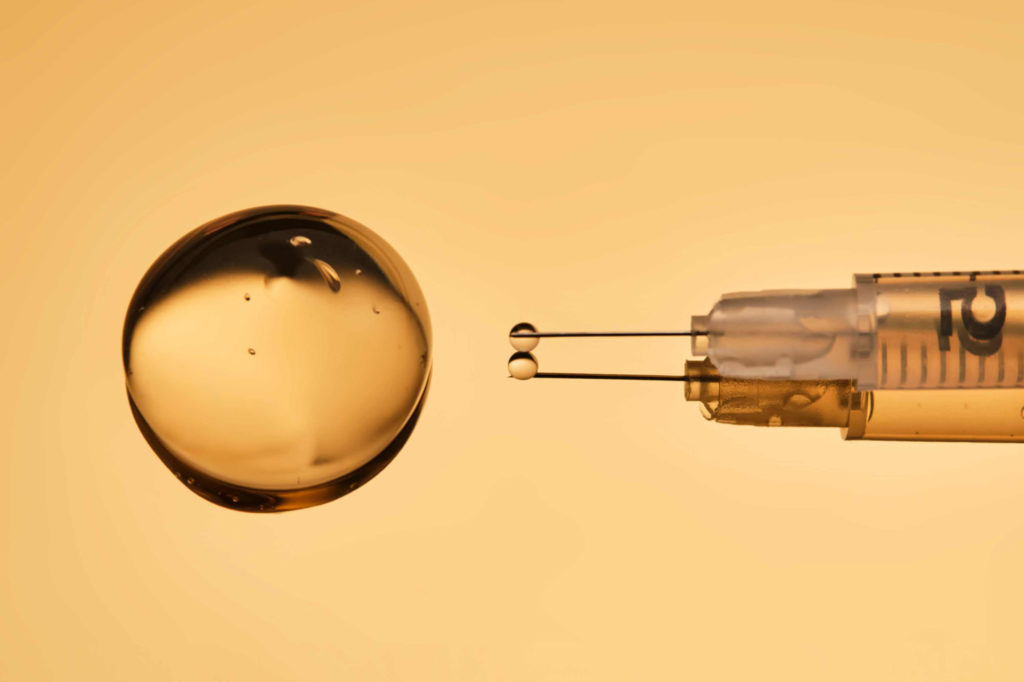Preconceived ideas
We regularly hear in consultation: “Doctor; OK for hyaluronic acid, but not botox. Hyaluronic acid is natural, we have it in our skin.”
Yes, it’s true that hyaluronic acid is present in the dermis, but that doesn’t mean that the hyaluronic acid injected for anti-aging purposes is “natural”. It’s an extremely well-tolerated, highly effective product, but it’s still a laboratory product. It cannot therefore be considered native or natural.
In my opinion, it is comparable to botulinum toxin in that, if injected under the right conditions, it is almost totally harmless and the result is perfectly harmonious, long-lasting and natural.
We also hear: “Doctor, I don’t want to be stiff, I don’t want to look like a doll, so I don’t want botox”. It’s true that too much botox can make the upper face look stiff. But the excesses of aesthetic medicine visible to all, those faces that don’t move, all round, “puffed up”, are generally linked to an excess of filler injections. These fillers (hyaluronic acid, calcium hydroxyapatite CaHA, poly-L-lactic acid PLLA, lipofilling fat) are often injected too superficially, creating a decorrelation between the skin and the underlying native fat, resulting in an expressionless, waxy, frozen face.
Here again, I often tell my patients that botulinum toxin and hyaluronic acid are extraordinary products which, when handled with delicacy and moderation, can make a big difference. They deliver natural, effective results. If the practitioner has undergone comprehensive training with a good grasp of anatomy and hands-on learning from quality experts, then these treatments are also extremely safe.
For those who are afraid of resorting to injections, I often add: “Injections are like salt in a recipe; if there’s none, it’s a bit bland; if there’s too much, it’s disgusting”.
What exactly is hyaluronic acid?
A little history
In 1934, Meyer and Palmer isolated a substance from bovine vitreous humor (vitreous humor is a gel contained in the orbit of the eye that basically maintains the shape of the eye, otherwise it would crush), which they called hyaluronic acid. This name comes from the Greek “hyalos” (vitreous) due to its presence in the vitreous humor, and “uronic” due to the presence of hexuronic acid. The more recent name “hyaluronan” has been used since 1984, in line with the international nomenclature for polysaccharides, to designate both hyaluronic acid and sodium hyaluronate.
A little chemistry
Hyaluronic acid is a sugar, a polysaccharide. It’s made up of small chains that repeat endlessly to form the complete hyaluronic acid molecule. It is these chains that will be cut by hyaluronidase to break down the hyaluronic acid.
A 70 kg human being contains around 15 g of hyaluronic acid, 50% of which is contained in the skin. There is a daily renewal of around 5 g, or 1/3, of the total hyaluronic acid contained in the body each day.
A little technology
You might say, but if hyaluronic acid is renewed by a third every day when it’s injected, it won’t last long. In reality, the synthetic hyaluronic acid produced in the laboratory will be cross-linked. In other words, the strands of hyaluronic acid, comparable to those found naturally in the skin, are linked by small bridges which solidify them and make them less sensitive to the hyaluronidase contained in the skin. In this way, the products will last much longer under the skin while being well tolerated. This also explains the different types of hyaluronic acid available. Thicker or softer, depending on the degree of cross-linking, i.e. the number of bridges that manufacturers place between the hyaluronic acid strands. The more hyaluronic acid is cross-linked, the “harder” it is and the longer it remains under the skin.
A little cooking
Hyaluronic acid is not only synthesized naturally in the body, but can also be produced by a variety of processes, for both medical and cosmetic purposes. In the past, hyaluronic acid was obtained by extraction from certain animal tissues rich in hyaluronic acid (e.g. cock’s crest). However, biofermentative production is by far the most modern and widespread method today. Special bacterial cultures synthesize a “vegan” hyaluronic acid by fermentation and filtration in several stages, which has the advantage of being particularly pure and high quality, free from allergens. Applied to the skin, hyaluronic acid penetrates quickly to provide optimal, long-lasting hydration, while soothing unpleasant skin irritations. When injected, it is very well tolerated, with virtually no inflammatory reaction.
In conclusion
Hyaluronic acid is actually produced naturally in the skin, but the hyaluronic acid we inject comes from industry. That said, it’s an extremely well-tolerated product that produces virtually no inflammatory side-effects, but it must be injected in the right place to avoid embolization-type complications. That’s why it’s vital that professionals authorized to inject hyaluronic acid undergo extremely rigorous training, with the emphasis on treatment safety. SAMBA training is the perfect answer to this need.
There’s a plethora of hyaluronic acid on the market, with laboratories from all over the world. Among the best known are the Allergan laboratory, which produces the Juvéderm range, the Galderma laboratory, which produces the Restylane range, the Merz laboratory, which produces the Belotero range, the Ibsa laboratory, which produces the Aliaxin range, the Vivacy laboratory, the Teoxane laboratory, the Croma laboratory, and many others.
So, compared to botulinum protein, it is not more natural, and its use does not produce more natural effects than botulinum toxin. It’s just a question of following the right indications and treating patients with moderation and harmony.
What exactly is botulinum toxin?
A little history
Botulinum toxin is a protein. It was isolated by Van Ermengen in 1987 from botulism patients.
Gradually, from the 70s and 80s onwards, it was used and thus produced in humans for the treatment of muscular hypertonia. For strabismus, but also for spasticity in neurological disorders, such as equinus feet. Botulinum toxin relaxes the muscles and thus corrects the hypertonia. Dr. Alan Scott, an ophthalmologist in the United States, was the first to use botulinum toxin to treat strabismus. He sold the rights to his discovery to the Allergan laboratory for $4.5 million … Regretfully.
A couple of Canadian doctors, the Carruthers, ophthalmologist and dermatologist, treated blepharospasm (uncontrolled blinking of the eyelid) in the glabella area (the lion’s wrinkle) and crow’s feet. These wrinkles are softened by relaxation of the corrugator and procerus muscles (frown lines) and the orbicularis muscle (crow’s feet). From that point on, the aesthetic indication was found, authorizations for use gradually appeared and botulinum toxin, as we know it for aesthetic purposes, made its sensational entry into the treatment and prevention of ageing wrinkles.
A little chemistry
This is a protein produced by a bacterium, clostridium, which blocks the neuromuscular junction by taking the place of acetylcholine. It’s a bit technical, but roughly speaking, when a muscle contracts voluntarily, there’s a small molecule between the nerve and the muscle, called a neurotransmitter. This neurotransmitter tells the muscles to contract when the nerve is stimulated. Botulinum toxin takes the place of this neurotransmitter, but is not active, so it will prevent muscle contraction. It’s all very well when it’s controlled, but in the case of botulism, it caused respiratory distress through paralysis of the respiratory muscles, resulting in patient death.
A little marketing
The general public calls botulinum toxin botox, but in fact botox is a trademark of the Allergan laboratory, which was the first to make botulinum toxin available.
Today, several laboratories produce botulinum toxin: Allergan produces botox and vistabel, Galderma produces Dysport and Azzalure, and Aluzience Merz produces Xeomin and Bocouture.
In conclusion
So, like hyaluronic acid, botulinum toxin is a synthetic product which has certainly been the focus of much fear and criticism of the excesses of cosmetic treatments, but which is only rarely responsible for the “failures of medicine and cosmetic surgery”.
On the contrary, from our point of view as aesthetic physicians, it’s an extremely effective product with almost total safety and a very limited risk of side effects, and above all, it’s reversible over time.
To sum up
As you can see, hyaluronic acid and botulinum toxin are 2 essential components of modern aesthetic medicine. They deliver natural, harmonious and long-lasting results, provided they are injected by professionals who have undergone the high-level theoretical and practical training offered by the SAMBA Academy of Aesthetic Medicine.






